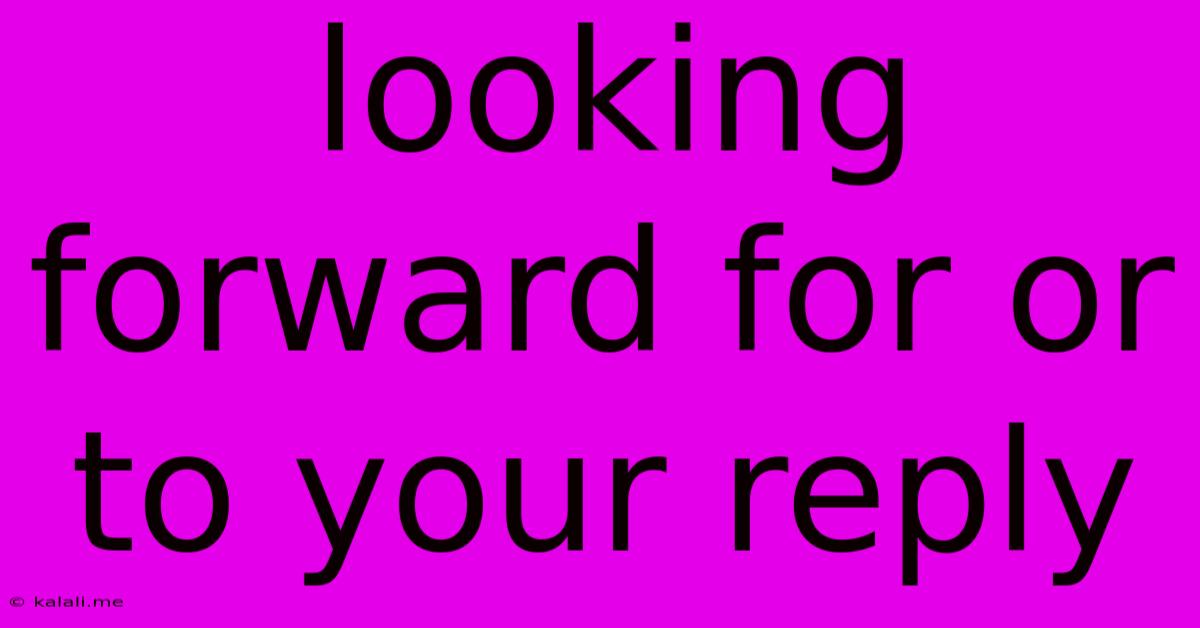Looking Forward For Or To Your Reply
Kalali
May 20, 2025 · 3 min read

Table of Contents
Looking Forward to Your Reply: Mastering Professional Email Etiquette
Looking forward to your reply. This seemingly simple closing phrase is a staple in professional emails, yet its subtle nuances can significantly impact the impression you leave. This article explores the proper usage of "looking forward to your reply" and offers alternatives for various contexts, ensuring your emails remain polished and effective.
Why "Looking Forward to Your Reply" Works (and When It Doesn't)
The phrase "looking forward to your reply" conveys politeness, professionalism, and a sense of anticipation. It subtly signals your interest in the recipient's response and implies the importance of the matter at hand. However, overuse or inappropriate placement can diminish its impact. It’s best suited for emails that require a response and where a timely reply is expected, such as:
- Requesting information: When you need data, clarification, or a decision from the recipient.
- Following up: When checking on the status of a previous communication or request.
- Scheduling meetings: Confirming meeting details or awaiting confirmation.
- Submitting proposals or applications: Expressing hope for a positive response.
Using this phrase in emails that don't require an immediate or active response can seem presumptive or even demanding. For instance, it's generally unnecessary in informational emails or newsletters.
Alternatives to "Looking Forward to Your Reply"
While "looking forward to your reply" is often appropriate, varying your closing can enhance the professionalism and diversity of your communication style. Here are some suitable alternatives:
- Thank you for your time and consideration: A more formal and respectful option, suitable for important matters.
- I appreciate your prompt attention to this matter: Suitable when a quick response is crucial.
- I look forward to hearing from you soon: A slightly softer alternative, suggesting a more relaxed timeframe for a response.
- Please let me know if you have any questions: Encourages interaction and clarifies any uncertainties.
- Best regards, or Sincerely, followed by your name: Simple and classic closings that work well in most professional contexts.
Placement and Contextual Considerations
The placement of "looking forward to your reply" is crucial. It typically appears just before your closing salutation (e.g., "Sincerely," or "Best regards,") or in a separate closing paragraph. Avoid placing it too early in the email, as this might appear overly eager or impatient.
Optimizing Email Communication for Better Results
Beyond the closing phrase, remember these key elements for effective professional emails:
- Clear subject line: Make it concise and descriptive, accurately reflecting the email's content.
- Concise and focused body: Avoid unnecessary jargon or rambling. Get straight to the point.
- Proofread carefully: Errors can undermine your professionalism.
- Appropriate tone: Maintain a professional and respectful tone throughout the email.
Mastering the art of professional email communication involves more than just the closing phrase. By understanding the nuances of "looking forward to your reply" and employing alternative closings strategically, you can improve your email effectiveness and project a polished, professional image. Remember to always tailor your closing to the specific context of your email and your relationship with the recipient.
Latest Posts
Latest Posts
-
What Has 1 Eye But Cannot See
May 21, 2025
-
What Bible Do Eastern Orthodox Use
May 21, 2025
-
Mac Connecting To Wifi But No Internet
May 21, 2025
-
How To Find Where You Died In Minecraft
May 21, 2025
-
Hope You Had A Good Holiday
May 21, 2025
Related Post
Thank you for visiting our website which covers about Looking Forward For Or To Your Reply . We hope the information provided has been useful to you. Feel free to contact us if you have any questions or need further assistance. See you next time and don't miss to bookmark.